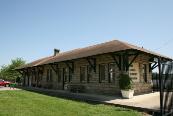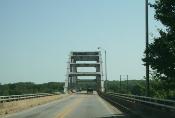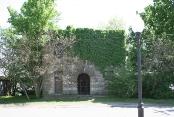


Ozark History Museum
Located in the restored Ozark
train depot, the museum is a
fascinating walk through time.
Located in the restored Ozark
train depot, the museum is a
fascinating walk through time.
Arkansas River Bridge
The view from the Arkansas
River Bridge in Ozark has
been ranked among the most
beautiful in America.
The view from the Arkansas
River Bridge in Ozark has
been ranked among the most
beautiful in America.
Ozark, Arkansas - Historic Sites & Points of Interest
ExploreSouthernHistory.com - Historic Sites of Ozark, Arkansas
ExploreSouthernHistory.com - Historic Sites of Ozark, Arkansas

| The Arkansas River at Ozark The view of the river and mountains from the bridge at Ozark, Arkansas, is one of the prettiest in the U.S. |
Scenic Beauty on the Arkansas
Nestled along a sweeping bend of the broad
Arkansas River can be found one of the most
charming communities in the Natural State,
the City of Ozark, Arkansas.
A noted landmark on the Arkansas River from
the earliest days of European exploration, the
Ozark area was frequented by French fur
trappers during the colonial era. It was
probably the adventurous souls that gave the
name "Aux Arcs" or Ozarks to area and rolling
mountains that rise here and sweep north
into Missouri.
Included in the Louisiana Purchase in 1803,
the vicinity became a stopping and crossing
point on the Arkansas River. The modern
community of Ozark was established here
during the 1830s. An important road grew
from Ozark to Fayetteville, following the route
of today's Pig Trail Scenic Byway, to connect
Northwest Arkansas with the river.
Ozark played a role on the Trail of Tears.
Steamboats traveling up the Arkansas River
often had to stop here during times of low
water and Native Americans camped at
Ozark before moving on to what is now
Oklahoma on foot. The waterfront is a
designated stop on the Trail of Tears route.
By the time of the Civil War, Ozark had grown
to become a community of around 100
people. Confederate troops established a
headquarters here after being defeated at
Pea Ridge and Prairie Grove in 1862. In April
of 1863, Brigadier General William L. Cabell
led 900 men from Ozark on an expedition that
ended at the Battle of Fayetteville.
Ozark itself became the scene of fighting
later that year and again in 1864. A number of
other skirmishes were also fought in the
vicinity and a monument on the grounds of
the Franklin County Courthouse pays tribute
to an officer killed just north of town.
Although Ozark prospered over the years, it
remained a small city on the river and that is
part of what gives it particular charm today.
The city serves as the southern starting point
for the Pig Trail Scenic Byway. This 19 mile
scenic drive begins just north of Ozark where
Highway 23 enters the Ozark National Forest.
Arkansas River can be found one of the most
charming communities in the Natural State,
the City of Ozark, Arkansas.
A noted landmark on the Arkansas River from
the earliest days of European exploration, the
Ozark area was frequented by French fur
trappers during the colonial era. It was
probably the adventurous souls that gave the
name "Aux Arcs" or Ozarks to area and rolling
mountains that rise here and sweep north
into Missouri.
Included in the Louisiana Purchase in 1803,
the vicinity became a stopping and crossing
point on the Arkansas River. The modern
community of Ozark was established here
during the 1830s. An important road grew
from Ozark to Fayetteville, following the route
of today's Pig Trail Scenic Byway, to connect
Northwest Arkansas with the river.
Ozark played a role on the Trail of Tears.
Steamboats traveling up the Arkansas River
often had to stop here during times of low
water and Native Americans camped at
Ozark before moving on to what is now
Oklahoma on foot. The waterfront is a
designated stop on the Trail of Tears route.
By the time of the Civil War, Ozark had grown
to become a community of around 100
people. Confederate troops established a
headquarters here after being defeated at
Pea Ridge and Prairie Grove in 1862. In April
of 1863, Brigadier General William L. Cabell
led 900 men from Ozark on an expedition that
ended at the Battle of Fayetteville.
Ozark itself became the scene of fighting
later that year and again in 1864. A number of
other skirmishes were also fought in the
vicinity and a monument on the grounds of
the Franklin County Courthouse pays tribute
to an officer killed just north of town.
Although Ozark prospered over the years, it
remained a small city on the river and that is
part of what gives it particular charm today.
The city serves as the southern starting point
for the Pig Trail Scenic Byway. This 19 mile
scenic drive begins just north of Ozark where
Highway 23 enters the Ozark National Forest.
The Pig Trail leads drivers through beautiful
rolling mountain country and past waterfalls,
rock formations and the beautiful Mulberry
River, popular for kayaking and canoing.
The downtown area of Ozark features a
variety of historic sites and structures. Among
these is the old train depot, located right on
the banks of the Arkansas River. Beautifully
restored, the structure is now a museum
housing a beautiful collection of artifacts and
memorabilia interpreting the history of the
area.
The Arkansas River Bridge at Ozark is
stunning, especially when it is beautifully lit at
night. The view from the bridge has been
ranked as one of the finest from any bridge in
the United States.
Ozark is located just off Interstate 40. The city
is 40 miles east of Fort Smith and 120 miles
west of Little Rock.
rolling mountain country and past waterfalls,
rock formations and the beautiful Mulberry
River, popular for kayaking and canoing.
The downtown area of Ozark features a
variety of historic sites and structures. Among
these is the old train depot, located right on
the banks of the Arkansas River. Beautifully
restored, the structure is now a museum
housing a beautiful collection of artifacts and
memorabilia interpreting the history of the
area.
The Arkansas River Bridge at Ozark is
stunning, especially when it is beautifully lit at
night. The view from the bridge has been
ranked as one of the finest from any bridge in
the United States.
Ozark is located just off Interstate 40. The city
is 40 miles east of Fort Smith and 120 miles
west of Little Rock.

Southern End of the Pig Trail
Ozark is a popular place for
food and rest while exploring
the Pig Trail Scenic Byway.
Ozark is a popular place for
food and rest while exploring
the Pig Trail Scenic Byway.

Old Jail in Ozark
The stone facade of the old
jail looks a bit like a small
castle.
The stone facade of the old
jail looks a bit like a small
castle.

Ozark National Forest
Pig Trail Scenic Byway
Mulberry River
Mulberry Area Waterfalls
Historic Sites in Arkansas
Explore other Southern Historic Sites
Pig Trail Scenic Byway
Mulberry River
Mulberry Area Waterfalls
Historic Sites in Arkansas
Explore other Southern Historic Sites






Custom Search
| Copyright 2011 by Dale Cox All rights reserved. |